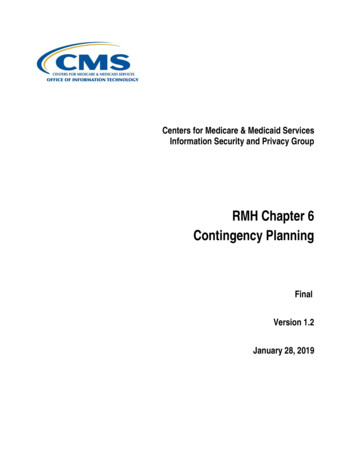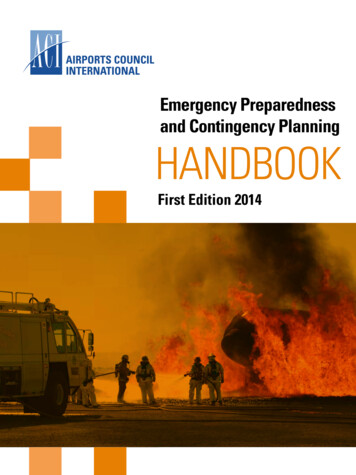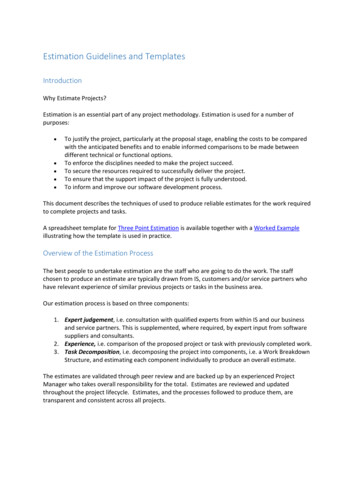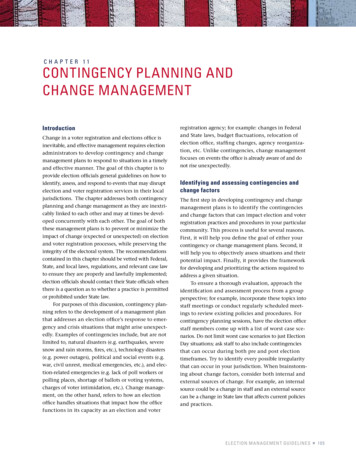
Transcription
Centers for Medicare & Medicaid ServicesInformation Security and Privacy GroupRMH Chapter 6Contingency PlanningFinalVersion 1.2January 28, 2019
Risk Management Handbook(This Page Left Intentionally Blank)January 28, 2019 - Version 1.2
Risk Management HandbookSUMMARY OF CHANGES IN CONTINGENCY PLANNING Version 1.21. Updates to Section 1.0 – Addition of figure showing suite of plans. Included language onvarious activities of Contingency Planning and their support of organizational resilience.2. Updates to Section 1.1 – Addition of figure showing integration of plans in the CMSeXpedited Life Cycle (XLC) along with language highlighting the plans in the XLC.3. Update to Section 2.2 – Aligned Recovery Tiers and corresponding RTO and RPOmetrics with current CMS DR strategy.4. Addition to Roles and Responsibilities of the Administrator and Agency Continuity Pointof Contact roles and their responsibilities to align with update to IS2P2.5. Updated Disaster Recovery language throughout the document to align with current CMSDR strategy6. General edits to format i.e. Table of Contents, paragraph indent, bullet points, etc.7. Update to links within the document.January 28, 2019 - Version 1.2
Risk Management LE OF CONTENTSINTRODUCTION . 7BACKGROUND . 8CONTINGENCY PLANNING REQUIREMENTS . 11CRITICAL RECOVERY METRICS . 122.1.1 MAXIMUM TOLERABLE DOWNTIME (MTD) . 132.1.2 RECOVERY TIME OBJECTIVE (RTO) . 14RECOVERY TIERS . 142.2.1 RECOVERY POINT OBJECTIVE (RPO) . 142.2.2 WORK RECOVERY TIME (WRT) . 15DISASTER TYPES . 152.3.1 TYPE A DISASTER. 162.3.2 TYPE B DISASTER . 162.3.3 TYPE C DISASTER . 16RECOVERY STRATEGY ANALYSIS . 172.4.1 DISASTER MITIGATION STRATEGIES . 192.4.2 RECOVERY TO A TRUSTED STATE . 19CONTINGENCY PLAN DEVELOPMENT . 192.5.1 PLANNING COORDINATION . 202.5.2 PLANNING ASSUMPTIONS . 212.5.3 PLAN FORMAT . 222.5.3.1ALERT AND NOTIFICATION PHASE . 232.5.3.2RECOVERY PHASE . 242.5.3.3RECONSTITUTION PHASE . 252.5.3.4NORMALIZATION . 252.5.3.5APPENDICES . 25EXERCISING AND TRAINING . 282.6.1 EXERCISING . 282.6.1.1TABLETOP EXERCISES . 292.6.1.2FUNCTIONAL EXERCISES . 292.6.2 TRAINING . 29ROLES AND RESPONSIBILITIES. 30PERSONNEL ROLES AND RESPONSIBILITIES . 303.1.1 ADMINISTRATOR . 303.1.2 CHIEF INFORMATION SECURITY OFFICER (CISO) . 303.1.3 BUSINESS OWNERS . 303.1.4 CONTINGENCY PLAN COORDINATORS . 313.1.5 SYSTEM DEVELOPERS/MAINTAINERS. 313.1.6 INFRASTRUCTURE SUPPORT/DATA CENTER . 31RECOVERY TEAM ROLES AND RESPONSIBILITIES. 323.2.1 CP MANAGEMENT TEAM . 323.2.2 CP RECOVERY TEAM . 32APPROVED . 34January 28, 2019 - Version 1.2
Risk Management HandbookFiguresFigure 1: Suite of Plans . 7Figure 2: Contingency Planning in the XLC . 9Figure 3: Relationship Between Recovery Metrics . 13Figure 4: Response Plan Relationships . 21Figure 5: Contingency Planning Format . 27TablesTable 1: MTD Determination . 13Table 2: Recovery Tiers . 14Table 3: RTO Adjustments . 15Table 4: Disaster Types . 16Table 5: Facility (Work Area) Recovery Strategy Matrix . 17Table 6: Hardware Recovery Strategy Matrix. 18Table 7: Software Recovery Strategy Matrix . 18Table 8: Data Recovery Strategy Matrix . 18Table 9: SP 800-34 Appendices . 22January 28, 2019 - Version 1.2
Risk Management Handbook(This Page Left Intentionally Blank)January 28, 2019 - Version 1.2
Risk Management Handbook1.0 INTRODUCTIONInformation Systems 1 play a vital role in CMS’ core business processes. It is critical that servicesprovided by CMS remain available and that applications that enable those services continue tooperate effectively and with minimal interruption. Contingency Planning provides instructions,disaster declaration criteria, and procedures to recover information systems and associated servicesafter a disruption through a suite of plans and documents including the Business Impact Analysis(BIA), Continuity of Operations (COOP), Disaster Recovery Plan (DRP), and the ContingencyPlan (CP).Figure 1: Suite of Plans1An information system is defined as “A discrete set of information resources organized for the collection,processing, maintenance, use, sharing, dissemination, or disposition of information” in the CMS Risk ManagementHandbook (RMH), Volume I, Chapter 10, CMS Risk Management Terms, Definitions, and Acronyms. available ty/Information-Security-Library.htmlJanuary 28, 2019 - Version 1.27
Risk Management HandbookOwing that each information system is unique the contingency planning provides preventivemeasures, recovery strategies, and technical considerations appropriate to the system’s informationconfidentiality, integrity, and availability requirements and the system impact level.There are many threats and hazards to organizations, both man-made and natural, ranging fromcyber to environmental and disasters can strike at any time thus it is vital for an organization tohave the ability to sustain its mission essential functions through any disruption or loss ofoperations. While no organization can expect to completely mitigate all threats, vulnerabilities,and risks there are resiliency activities that can be taken to continue its mission essential functions,i.e. Continuity of Operations (COOP, in the face of a disruption. Contingency Planning, coupledwith risk management, disaster recovery, and continuity planning, acts as a component in supportof resiliency.1.1BACKGROUNDCMS is reliant on its information systems for mission fulfillment. Information systems aresusceptible to a wide variety of events and threats that may affect their ability to process, store andtransmit raw data and information. Contingency planning is one method of reducing risk to CMS’operations by providing prioritized, efficient, and cost effective recovery strategies and proceduresfor the organizations’ Information Technology (IT) infrastructure. The varying plans associatedwith Contingency Planning work together within the eXpedited Life Cycle in an effort to reducerisk, implement adequate security, and minimize additional costs to CMS operations.January 28, 2019 - Version 1.28
Risk Management HandbookFigure 2: Contingency Planning in the XLCThe CMS Contingency Planning RMH follows the guidance of the NationalInstitute of Standards and Technology (NIST) and most specifically with NIST SpecialPublication (SP) 800-34. From this effective contingency planning follows 7 related steps as partof the overall CP process:Contingency Planning policy2Business Impact AnalysisPreventive ControlsContingency StrategiesContingency PlanTesting, Training, and Exercises (TT&E)Contingency Plan maintenance 2For Contingency Planning Policy statements please see the IS2P2, as amended, located ecurity/Information-Security-Library.htmlJanuary 28, 2019 - Version 1.29
Risk Management HandbookThese, in turn, require: Accurate identification of functions performed by the system, Accurately mapping any functions that rely on other systems, Determining impact to the organization for loss of any or all functions (and therebydetermine functional recovery prioritization), Proper resource allocation, Identification of backup methods, Emergency maintenance service level agreements (SLA), Periodic testing, training, and exercises for personnel, and Regular reviews and updates for CP plans due to technological changes, shifting businessneeds, system changes, and/or changes to policy.DevelopContingencyPlanningPolicy ngencyPlan (CP-2)Plan Testing,Training, andExercises (CP3, CP-4)PlanMaintenanceFigure 3: Contingency Plan ProcessAt CMS the Information Security and Privacy Group (ISPG) provides the Contingency PlanningPolicy in the Information Systems Security and Privacy Policy (IS2P2) 3. With the ContingencyPlanning Policy in place the next step of the process is for the Business Owner and System Ownerto conduct the Business Impact Analysis (BIA) which will help inform the Contingency Planningprocess such as identifying preventive controls for the system(s), and in developing theContingency Plan. As explained later in this document there are testing, training, and exerciserequirements for system contingency plans in addition to routine maintenance of the plan to ensureit is kept up to date and aligns with any system, policy, or other changes that impact the ormationSecurity/Downloads/IS2P2.pdfJanuary 28, 2019 - Version 1.210
Risk Management Handbook2.0 CONTINGENCY PLANNING REQUIREMENTSThe following requirements apply: All business owners must develop Contingency Plans (CPs) for each information systemto meet operational needs in the event of a disruption.A standard framework of COOP and DR plans should be developed by the ContingencyPlanning Team from the senior leadership level down to the individual system plans,reviewed by the Information System Security Officer (ISSO) or the Contingency PlanCoordinator (CPC), and approved by the Business Owner (BO) with a copy provided tothe Chief Information Security Officer (CISO).Each Business Owner will: Actively participate in the determination of Maximum Tolerable Downtime (MTD) 4,Recovery Time Objective (RTO) 5, Recovery Point Objective (RPO) 6, and WorkRecovery Time (WRT) 7 determinations;Identifying and documenting other systems that use data from the IS as well as thosesystems that feed data to the ISReview each of their CPs at a minimum annually, or when a major change occurs to thesystem, and ensure either the ISSO or CP Coordinator updates the plan as necessary.Ensure CPs assign specific responsibilities to designated staff and elements of the CPrecovery team to facilitate the recovery of each system within approved recovery periods.Ensure the necessary resources are available to ensure a viable recovery capability.Ensure that personnel who are responsible for systems recovery are trained to execute thecontingency procedures to which they are assigned.Ensure CPs are exercised and tested for effectiveness annually. The CPCs and/or ISSOsshall observe all exercises and document instances where appropriately trained personnelwere unable to complete the necessary recovery procedures. Such shortcomings arecaused by weaknesses in the plan and contingency plans will be adjusted to correct theidentified plan deficiencies through the use of After Action Reports (AARs) and Plan ofAction and Milestones (POA&M).Annual exercises will be used to verify the viability of each CP and are not intended to test thetechnical competence of individual personnel but rather to demonstrate working knowledge4MTD (Maximum Tolerable Downtime) is the amount of time mission/business process can be disrupted withoutcausing significant harm to the organization’s mission. (SP 800-34)5RTO (Recovery Time Objective) is the overall length of time an information system’s components can be in therecovery phase before negatively affecting the organization’s mission or mission/business processes. (SP 800-34)6RPO is the point in time to which data must be recovered after an outage. SP 800-34 (revision 1) dated May,2010. RPO is the requirement for data currency and validates the frequency with which backups are conductedand off-site rotations performed.7WRT (Work Recovery Time) is the time it takes to get critical business functions back up-and-running once thesystems (hardware, software, and configuration) are restored to the RPO. This includes the manual processesnecessary to verify that the system has been restored to the RPO, and all necessary processes have been completedto address the remaining lost, or out-of-synch, data or business processes.January 28, 2019 - Version 1.211
Risk Management Handbookand understanding of the Recovery Team’s roles and responsibilities in recovery of the systemto an operational status. The primary purposes of annual CP exercises are: 2.1Identify weaknesses in each planTrain personnel in their recovery responsibilities to ensure viable recovery capabilities.CRITICAL RECOVERY METRICSBusiness owners should establish and have a clear understanding of the essential functions,processes, and applications that are critical to CMS and the point in time when the impact(s) of theinterruption or disruption becomes unacceptable to the entity. The Mission Essential Functions(MEFs) at CMS are:1.2.Cash Flow to external stakeholders to prevent lapses in health care coverage.Enrollment of individuals in Medicare, Medicaid, and Children’s Health InsuranceProgram (CHIP), and in private health care plans through the Health InsuranceMarketplace.Communication of health, policy, and emergency information to internal and externalstakeholders.End Stage Renal Disease (ESRD) patient and facility tracking.Quality Care for CMS program beneficiaries.3.4.5.These MEFs are identified for each system during the BIA and assist in identifying the toppriorities for CMS. For instance, an information system that supports a Primary Mission EssentialFunction (PMEF) has an MTD of 0 despite what a comparable system not supporting a PMEFwould have for its MTD.Other timeframes or recovery goals that drive recovery options (strategies) and cost are: MTD of each mission/business process;RTO of each system that is used to enable each of those functions;RPO of the data; andThe WRT for each function;Recovery requirements for each function include but are not limited to:Personnel/skill sets;Essential records;One-off work stations;Specialized office equipment;Short term impact on delivery of services to beneficiaries;Short term impact on delivery of services to providers;Short term operational impact to system users;Short term operational impact to all databases for which the application provides eitherraw data or information;Cost of lost productivity;The backlog that may accrue for every hour or day that the system is unavailable;The length of time it would take to catch up with all backlogged transactions while stillprocessing new requirements (or until new requirements can be processed);January 28, 2019 - Version 1.212
Risk Management Handbook The point in time when it may be necessary to shift resources from other functions toassist with clearing the backlog, causing a “domino effect” of the disaster; andThe point in time at which too much data or too many transactions have been lost,causing public recognition of the disaster and negative impact to the reputation of CMS.Figure 4: Relationship Between Recovery Metrics2.1.1 MAXIMUM TOLERABLE DOWNTIME (MTD)The foundation of all recovery planning is the prioritization of business processes and functions.The MTD for each business process/function is established during the Information SystemDescription task of the NIST Risk Management Framework. This task occurs during theInitiation, Concept, and Planning phase of the eXpedited Life Cycle (XLC), as explained in theRisk Management Handbook (RMH) Chapter 12 Security and Privacy Planning 8. Each businessowner ensures identification of the following information: The relevant business process(es) and function(s),A quantified statement of the potential Impact an outage has on the business process, andthe MTD for each individual business process.Table 1 is an example of the MTD determination for a hypothetical function. 9Table 1: MTD DeterminationBusinessFunctionClaims ProcessingPotential ImpactsMaximum TolerableDowntimeOperations – more than 1000 customers affectednationally72 hoursReputation –congressional interest30 hoursReputation – media interest36 hoursCustomer Service – Over 500 beneficiary complaints36 vacy-Planning.pdf9The following data points are for example only and are not meant to represent an actual situation.January 28, 2019 - Version 1.213
Risk Management HandbookDocument results in the business risk assessment during the Initiation Concept, and Planningphase of a project. Later in the project, during development of the system contingency plan,place the MTD values in Appendix G.2.1.2 RECOVERY TIME OBJECTIVE (RTO)Determining the information system resource RTO is crucial for selecting appropriate technologiesthat are best suited for ensuring IT system recovery to support the functional MTD. The RTOdetermination occurs during the Requirements Analysis and Design phase of a project as requiredby RMH Chapter 12 Security and Privacy Planning. 10 The RTO must be fast enough to ensurethat the MTD can be attained. If a function can be recovered without a given system, then thatsystem’s RTO may be longer than the function MTD. However, if the function cannot berecovered for any length of time without the given system, the RTO must be significantly shorterthan the MTD because:It takes time to reprocess data that is restored from backups. The additional processing time mustbe added to the RTO to stay within the time limit established by the MTD; andIt takes time to process data created after the last backup that was taken off-site.The RTO will be documented in the information system description during the RequirementsAnalysis and Design Phase of the project. Once the RTO is determined, add it to CP Appendix Gwhen developing that document.2.2RECOVERY TIERSA clearly defined RTO and associated recovery tier will be applied to each system in accordancewith the table below. Table 2 depicts the Enterprise Data Center (EDC) recovery tier structure andcorresponding Recovery Time Objectives (RTOs) and Recovery Point Objectives (RPOs) to assistin enterprise-wide recovery planning.Table 2: Recovery TiersRecovery RequirementsTier ZeroInfrastructureRTO: 4 hrsRPO: 15 minsTier OneHot SiteRTO: 4-8 hrsRPO: 15-60 minsTier TwoWarm SiteRTO: 8-24 hrsRPO: 1-12 hrsTier ThreeBare Metal SiteRTO: 24-72 hrsRPO: 12-24 hrsBest EffortCold SiteRTO: 72 hrsRPO: 24 hours2.2.1 RECOVERY POINT OBJECTIVE (RPO)The RPO, expressed as a time (e.g. 24 hours' worth of data) defines the maximum acceptableamount of data that can be lost due to a disruptive event. The RPO validates or repudiates acy-Planning.pdfJanuary 28, 2019 - Version 1.214
Risk Management Handbookcurrent back up schema and determines the data backup strategy. The Business Owner and the ITinfrastructure maintainer must both agree to the RPO.Regarding backup strategies: Shorter RPOs have fewer strategies that can meet those requirements and those strategiesare more expensive than strategies that support longer RPOs.The MTD is impacted by the RPO and the requisite backup strategy, because the amountof data loss directly affects the amount of work and processing that must be done after thesystem is restored, before business operations become current. Generally:Longer RPOs require longer WRTs before a function is fully recovered.Shorter RPOs have shorter WRT efforts before a function is fully recovered.2.2.2 WORK RECOVERY TIME (WRT)It is relatively easy to determine functional MTDs and IT system RTOs. However, determiningWRT may not be as easy, as there is no federal regulation or guidance that addresses this concept.The best way to determine WRT is first to have an approved functional MTD, which will be thelongest timeframe for any recovery requirement.The relationship between RTO, WRT and MTD can be stated as a simple equation, i.e. RTO WRT MTD. Any system RTO and functional WRT combined cannot exceed the function MTD.Then take into account the amount of acceptable data loss (established by the RPO), datavalidation, and any other operational procedure that impedes the ability to bring back a functionto the point of processing new transactions on a current basis. CYCLICAL RECOVERY TIMEOBJECTIVE (RTO) ADJUSTMENTSShould this system incur an operational peak where the RTO becomes shorter, or an operationalwhere recovery can be delayed, the RTO adjustment will be annotated as indicated in Table 3.Operational peaks and ebbs do not invalidate system RTOs that have been determined. The CPwill identify the “normal” RTO as well as any cyclical adjustments in Appendix G.Table 3: RTO AdjustmentsWhen does the RTO shiftReliant Function2.3(i.e. time of month, quarter, year)Modified RTODISASTER TYPESThe purpose for identifying types of disasters is only to quickly identify the scope of the disaster.The primary method of communicating disasters to information system(s) owners and informationJanuary 28, 2019 - Version 1.215
Risk Management Handbooksecurity officers is directed by the CMS Incident Management Team (IMT). 11 It is not forproviding the disaster declaration criteria nor is it an attempt to identify the specific event thatcaused disaster. Three types of disaster may occur: Type A, Type B or Type C. Each of thesethree types is defined below.2.3.1 TYPE A DISASTERThis level of disaster is one that affects a single application affecting a single line of business.Neither the supporting infrastructure nor the hosting system would be physically damaged orrendered inoperable. The problem is correctable with minimal resources and the recovery teamsspecified in the CP, while placed on alert, may not be activated. The declaration authority for aType A disaster is the business owner.2.3.2 TYPE B DISASTERThis type of disaster involves a portion of the enterprise whose impact encompasses multipleapplications, systems or multiple lines of business. A Type B disaster will either affect; an entiresystem with impact to all hosted applications, or a major centrally accessed database, the loss ofwhich affects a significant portion of CMS’ mission. The declaration authority for a Type Bdisaster may be the affected business owners (to include the supporting infrastructure businessowner).2.3.3 TYPE C DISASTERThis type of disaster will render most of the supporting infrastructure inoperable. A Type CDisaster will require the transition of all supporting infrastructure functions and services to thealternate processing facility and the implementation of CPs in priority order as directed by thesupporting infrastructure Business Owner.Table 4 summarizes the disaster types.Table 4: Disaster TypesDisasterTypeDescriptionType AAffects a single application affecting a single line of business.Type BInvolves a portion of the enterprise whose impact encompasses multiple applications,systems or multiple lines of business.Type CRenders most of the supporting infrastructure equipment Response.pdfJanuary 28, 2019 - Version 1.216
Risk Management Handbook2.4RECOVERY STRATEGY ANALYSISThe business owner will require identification and implementation of viable and effectivestrategies commensurate with meeting business process MTD as part of a new system project. Forexisting systems, the business owner needs to make sure a viable strategy is in place and effective.When considering recovery requirements a shorter MTD requires a shorter RTO, thus reducing theapplicable strategies that are available and increasing the cost of those strategies.The following four impacts (either individually or in combination) constitute the onlyconsequences of any disaster and therefore must be addressed in any recovery strategy analysis: Loss of personnel;Loss of computing (to include hardware or software and/or data);Loss of power;Loss of telecommunications; andDenial of facility access.Because the four impacts can occur in combination, all should be considered when selectingrecovery strategies.Business owners must conduct their own research in order to implement the most effectivestrategies that meet their individual requirements. Although it may seem expedient to implementthe strategies associated with the shortest RTO, bear in mind that this “default” approach wouldprobably not be the most cost-effective. In addition, business owners implementing new systemsat existing IT infrastructure may have lower costs for the strategy than they would have if systemdeployment were at a new IT infrastructure facility, stemming from sharable components andresources. For existing systems, the business owner needs work with the DR Team and other ITcomponents to develop and implement a viable and effective strategy. When developing recoveryprocedures, each Business Owner and ISSO will ensure the system can be recovered to the lasttrusted state. Partial lists of potential strategies for Loss of computing are included in Table 5through Table 8.Table 5: Facility (Work Area) Recovery Strategy MatrixRecovery Tier/RTOTier 0: 0 - 4 hoursTier 1: 4 – 8 hoursTier 2: 8 – 24 hoursTier 3: 24 – 72 hoursStrategiesFixed hotsite (processing, work area and data storage). Telework (work areaonly).Mutual support agreement (processing, work area, and data storage).Warm site, cold site.Mobile trailer-transported hotsite (processing).Defer recovery until reconstitution completion.Warm site, cold site.Mobile trailer-transported hotsite (processing).Defer recovery until reconstitution com
transmit raw data and information. Contingency planning is one method of reducing risk to CMS' operations by providing prioritized, efficient, and cost effective recovery strategies and procedures for the organizations' Information Technology (IT) infrastructure. The varying plans associated










